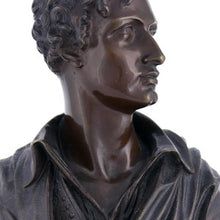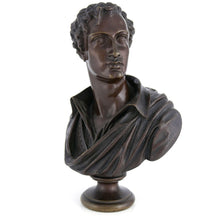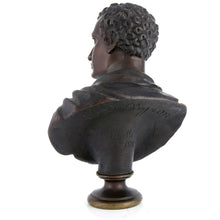George Gordon, 6th Lord Byron Desk Bust, 1860
- Regular price
- £925
- Sale price
- £925
- Regular price
-
- Unit price
- /per
Adding product to your cart
Height overall: 21cm (8.2in)
Patinated bronze. Portrait bust of Lord Byron (1788-1824) cloaked and looking left. Raised on an integral bronze socle, Titled and signed ‘Lord Byron / E. Hiolle 2me Prix. ‘
George Gordon, 6th Baron Byron's significance in the context of the Napoleonic Wars is his commentary on the Battle of Waterloo in his epic poem Childe Harold's Pilgrimage - ‘There was a sound of revelry by night', as the Duchess of Richmond's ball is memorably described). Moreover, Byron is also a good example of how the French Revolutionary and Napoleonic Wars touched the lives of many outside the spheres of military or political life. Byron inherited his title from his great-uncle William, 5th Baron (1722-98) only because his direct heir, his grandson Lieutenant William Byron, 18th Foot, had been killed in action on 31 July 1794 during the siege of Calvi.
Ernest-Eugène Hiolle (1834-1886) studied at the École Académique, Valciennes before studying under François Jouffroy and Laurent Séverin Grandfils at the École des Beaux-Arts in Paris. He was runner up in the Prix de Rome of 1856 and won it in 1863. Exhibiting at the Salon from 1866, he won medals from 1867 to 1870. After 1870 he participated in the great public building projects of the French Third Republic with sculpture for the Palais Garnier, the Hôtel de Ville, Paris, and elsewhere. In 1873 he was made a Chevalier of the Légion d'honneur.








